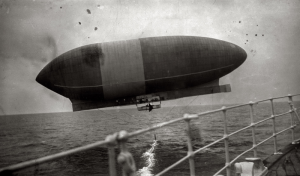Historic Airship Flight Ended Off Bermuda
 The centenary of the first attempt to cross the Atlantic by air — a flight in an ungainly hydrogen-filled blimp which ended in near-disaster off Bermuda [pictured at left] — is being commemorated with a new permanent exhibit at the Smithsonian Institution in Washington, DC.
The centenary of the first attempt to cross the Atlantic by air — a flight in an ungainly hydrogen-filled blimp which ended in near-disaster off Bermuda [pictured at left] — is being commemorated with a new permanent exhibit at the Smithsonian Institution in Washington, DC.
The pioneering 1910 flight of the airship “America”, long consigned to footnote status by aviation historians, is being reappraised by scholars given the ambition of the six adventurers — and one feline – involved in the attempt.
Their attempt to cross the Atlantic came just a decade years after the first modern dirigible was launched and seven years after the Wright Brothers’ motorised glider sputtered into the air at Kitty Hawk, North Carolina.
Recently the Goodyear Tire & Rubber Co. donated the historic lifeboat used on the “Atlantic’s” failed ocean crossing to a new Smithsonian display commemorating the flight.
The ”America” crew was rescued in the craft and the first wireless message from a powered aircraft was sent from the radio position in the lifeboat.
The lifeboat is 27 feet long with a six-foot beam and is constructed of three thicknesses of mahogany veneer.
 “We are delighted to have acquired this forgotten piece of early aviation history,” said Tom Crouch, senior curator of aeronautics at the Smithsonian’s National Air & Space Museum.
“We are delighted to have acquired this forgotten piece of early aviation history,” said Tom Crouch, senior curator of aeronautics at the Smithsonian’s National Air & Space Museum.
“After a period of clean-up and a conservation assessment, it will be displayed at the Steven F. Udvar-Hazy Centre, close to two other historic transatlantic aircraft — the Double Eagle II gondola, which carried the first balloonists to Europe in 1978, and the Concorde, which pioneered supersonic transatlantic travel.”
American newspaper publisher Walter Wellman purchased the sturdy lifeboat from an English firm in 1910 as he was preparing to attempt the first powered flight across the Atlantic in the ‘America’.
In addition to its basic role as a refuge for the crew should they be forced down at sea, the lifeboat doubled as a kitchen, pantry, dispensary, smoking lounge and radio position. It also served as a hiding place for “Kiddo,” a feline stowaway discovered by Mr. Wellman and his five man crew after take-off on October 16, 1910 from New Jersey.
The airship, its crew and the cat remained aloft for 38 hours, but were forced down just off Bermuda due to a combination of engine problems and bad weather.
“Their salvation depended on crossing the path of a Royal Mail Ship, the ‘Trent’, which (they) knew was sailing from Bermuda to New York at the time,” reported the “Daily Telegraph” in a recent report marking the centenary of the “Atlantic’s” ill-fated flight.
“At 5 a.m. on the morning of October 18 … Wellman spotted the ship. Soon, the ‘America’s’ crew were communicating with the ‘Trent’ by Morse code and then by radio.
“After a hazardous operation, with the airship being blown along at speeds of up to 25 knots, the lifeboat was eventually lowered safely into the sea, complete with all crew, including the cat. The airship, still airborne, and now considerably lighter, vanished over the horizon.
“The ‘Trent’ gave the crew safe passage to New York, where they were welcomed as heroes. ‘Kiddo’ the cat was especially well received and put on display in a gilded cage in the famous Gimbels department store. He later went to live a quieter existence with Wellman’s daughter, Edith.”
The adventure made front page news around the world.
Mr. Wellman retired from the field, but Melvin Vaniman, his chief engineer, began planning for a transatlantic flight of his own. Frank Seiberling, the founder of Goodyear, agreed to manufacture the gas bag for the airship that would be known as the “Akron”, in honor of the company’s hometown. Mr. Vaniman decided to reuse Mr. Wellman’s lifeboat in his attempt.
On July 2, 1912, after a series of test flights, aeronaut Mr. Vaniman and his five-man crew steered the “Akron” up and away from his Atlantic City, New Jersey, hangar.
The airship had barely crossed the coastline when, 500 feet in the air, the 11,300 cubic meters of hydrogen in the gas bag caught fire, plunging the crew to their deaths.
The lifeboat was salvaged from the shallow coastal waters and shipped back to Goodyear, where it would spend the next 98 years in storage at the company’s Wingfoot Lake airship facility outside Akron.
(Photos courtesy of Smithsonian Institution)



Bernews, I commend you on your historic pieces! They are very entertaining and enlightening as well. Thank you, and keep up the good work!
Hi folks,
This is an interesting article on a historic flight that is often overlooked by avaition historians. The odd thing about this trans Atlantric attempt was the way the crew were regarded as heroes, when the flight was a failure.
If you like airships of any type and are in the mood for a Helium sniffing laugh see my Gasbags site: http://www.hybridblimp.net for the worlds only lighter than air comedy site.
Regards JB